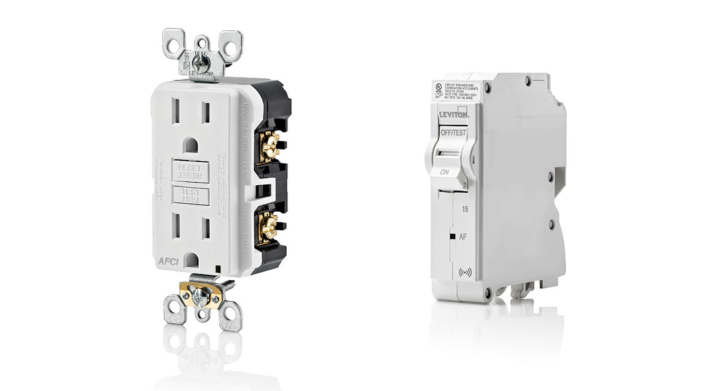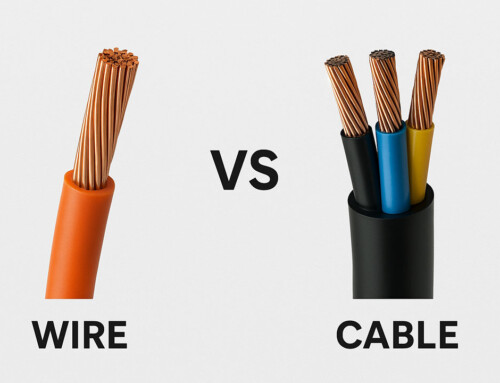Table of Contents
Image: leviton.com
Table of Content
- Arc Fault vs. Short Circuit vs. Ground Fault
- Common causes of Arc Faults
- How does Arc fault circuit Interrupter(AFCI) Breaker/ Receptacles work?
- What is an Arc fault breaker?
- How to Install an AFCI Breaker?
- What is an Arc Fault Circuit Interrupter (AFCI) receptacle?
- The Process of Installing an Arc fault circuit interrupter (AFCI) Receptacle
- Where should an Arc fault circuit Interrupter(AFCI) Breaker/ Receptacles
If you have ever experienced loose wiring connections causing spark due to unsteady contact, then you understand how dangerous it could be if not treated carefully. That spark between metal contact points leading to noises or unsafe passing of electrical current is known as an arc fault. Soon enough, this arcing gets heated up and breaks the insulation around each conducting wire.
Arcing creates high-intensity heating at the point of contact, resulting inflaming of the particles within the wires. Such raised temperature can exceed 10,000 degrees Fahrenheit that is capable of igniting materials placed nearby.
Although arcing does not necessarily, have to be accidental. In some cases, it is intentionally created, with an arc welder to serve a specific need. But to prevent a fire hazard, you should immediately take necessary precautions when you notice any loose wiring connections or hear noises from the switches. That is where an Arc Fault Circuit Breaker comes as the ideal solution.
Arc Fault vs. Short Circuit vs. Ground Fault
Referring to all three to mean the same is incorrect. Each phenomenon indicates a different situation and requires a different strategy for prevention.
A Short-circuit occurs when the electrical current strays outside its established wiring connection and comes in contact with the neutral wiring system or the grounding system. That leads to an unforeseen loss of resistance in the flow of the current with sudden jumps in volume. Such a high flow of current eventually exceeds the amperage capacity of the circuit breaker, leading to its tripping to obstruct the connection.
A Ground fault is another particular type of short circuit in which the electrical current produces accidental contact with the ground. Similar to other short circuit situations, a ground fault also leads to resistance loss with an unrestrained flow of current, ultimately causing the circuit breaker to trip. However, there is a possibility that the circuit breaker might not be able to operate fast enough to protect you from a shock. To avoid such situations, the electrical Code recommends installing GFCIs (Ground-Fault Circuit Interrupters), in specific locations prone to ground faults. GFCIs quickly sense any power changes and shut down a circuit before a shock wave can pass.
An Arc fault is dangerous, fire-causing sparking that occurs due to corroded wiring systems. Arc faults could possibly be a precursor to a short circuit or ground-fault, but neither a GFCI nor a circuit breaker works appropriately to prevent arc fault hazards. An AFCI (arc-fault circuit interrupter) or an arc fault breaker is a specialized device used chiefly as a safety measure against arc faults.
Common causes of Arc Faults
- Arcing due to physical damage in electrical wiring system. Such as:
Wires are accidentally damaged by nails or screws
Animals and vermin chewing the wire insulation layer
Damage on insulation layer due to Heat, humidity and voltage stress
- Arcing due to loose connection.
- Arcing due to improper joints in the circuit or at outlets
- Arcing due to extension cords
- Arcing due to damaged appliances or electrical devices
Devices to use for protection from arc fault
- Arc fault breaker – It is responsible for shutting down the whole circuit and likewise is installed in the breaker box.
- Arc Fault Circuit Interrupter (AFCI) receptacle – It comes with a proper outlet branch intended to defend the branch circuit wiring connected to it against a posed risk of fire ignition.
How does Arc fault circuit Interrupter(AFCI) Breaker/ Receptacles work?
The AFCI breaker/ receptacles circuitry always monitors the current flow throughout the wiring system. AFCI uses detection systems to distinguish between normal and unwanted arcing conditions. During an unwanted arcing, the AFCI breaker/ receptacle trips the internal contacts, de-energizing the circuit.
The technologically advanced AFCIs can easily distinguish between intentional and unintentional arcing and recognize how to act accordingly.
What is an Arc fault breaker?
Arc-fault breakers are devices designed to detect the unique electronic indication of a sparking or arcing connection. Upon discovery of any abnormal fluctuations, it trips the breaker, successfully preventing a fire. The arcing could be a result of a nail hammered or poking through a live wire, a rodent eating the wire, a corroded or worn-out electrical cord, or a miss-wired, failing product.
The AFCI breaker is a circuit breaker located in your electrical panel. It is ideally a regular breaker with the additional capability of obstructing the flow of electricity in the whole circuit if it senses any hazardous arcing. You can identify an AFCI receptacle by a unique, colored test-button placed near its handle.
How to Install an AFCI Breaker?
Follow the steps below to install an arc fault circuit breaker:
- Turn off the main circuit breaker, which will cut power in your entire house.
- Remove the panel cover after ensuring with a circuit tester that the power is off.
- Remove the old circuit breaker by separating the black wire from the breaker.
- Wire and connect the AFCI breaker’s coiled white wire with the neutral bus bar.
- Install the AFCI breaker, re-screw the panel cover, and turn on the power.
- Test the arc fault breaker.
What is an Arc Fault Circuit Interrupter (AFCI) receptacle?
AFCI receptacles, like AFCI circuit breakers, are the parts that contain electronic components used to monitor the circuit for a dangerous electrical arc. These receptacles are installed on the first outlet of the branch circuit and protect all the others.The Arc Fault Circuit Interrupter (AFCI) receptacle will trip and break the current flowing to the outlet where the arc is caused, while the remaining outlets will not be affected.
The Process of Installing an Arc fault circuit interrupter (AFCI) Receptacle
Refer to the following steps for assistance:
- Turn off the power supply on both outlets by turning the breaker to the off position or removing the fuse.
- Remove the old outlet, which will be replaced by the arc fault receptacle.
- Identify the exposed, current-carrying cables using a tester and mark them.
- Connect the line cable and grounding wires to the AFCI receptacle.
- Test your work to recognize any miswiring.
Where should an Arc fault circuit Interrupter(AFCI) Breaker/ Receptacles be installed?
The Arc fault circuit Interrupter(AFCI) Breaker/ Receptacles should be installed in
- Bedrooms
- Guest rooms
- Dormitory
- Sleeping areas
- Kitchens
- Laundry rooms
If you have made it so far in the article, you have a thorough understanding of the importance of an AFCI. Keep your space and your appliances fire-proof by installing one soon.
Contact D&F Liquidators at 800-458-9600. We have a large inventory of reliable electrical supplies, circuit breakers, and safety switches from top brands at competitive rates.






